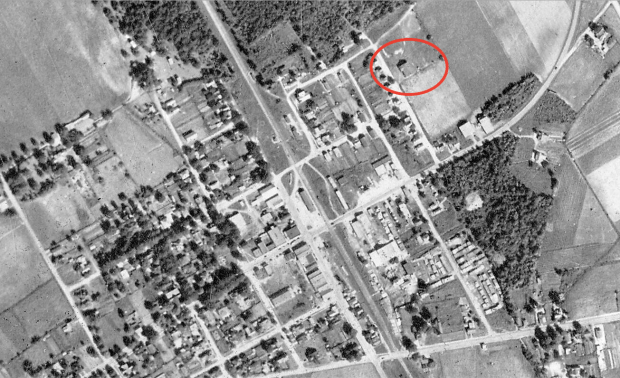On 1 February 1912, 11 Wayne and Greene County residents — members of an extended family — sold Robert Manuel, also of Wayne County and an in-law, a parcel of land described, in part, as “Lot No. 5 in the Division of the Public School lot for colored race District No. 1” on Stantonsburg and Moyton Road just outside the town of Stantonsburg.


Deed book 97, page 574, Wilson County Register of Deeds Office, Wilson.
What was Colored District No. 1? Where are its records? (And those of any other African-American county school districts?) Where on Stantonsburg and Moyton Road (N.C. 58?) was the public school lot in Stantonsburg? When was the lot divided?
——
- Andrew and Ada Lewis Sauls
In the 1880 census of Stantonsburg township, Wilson County: farmer Caleb Sauls, 35; wife Zany, 28; and children Henry, 4, Andrew, 2, and Mollie, 1.
In the 1900 census of Stantonsburg township, Wilson County: farmer Caleb Sauls, 51; wife Zany, 45; and children Henry, 23, Andrew, 21, Mollie, 20, Sudie, 18, Emma, 16, and Pet, 12.
In the 1910 census of Nahunta township, Wayne County, N.C.: Andrew Sauls, 31; wife Ada, 20; and children James, 4, Henry, 2, and Ed Rena, 1.
In the 1920 census of Nahunta township, Wayne County: Andrew Sauls, 41; wife Ada. 32; and children James, 14, Henry B., 12, Edrena, 11, William, 8, Lila Bell, 6, Lemon, 5, and Fremon, 2.
Andrew Sauls died 15 October 1930 in Nahunta township, Wayne County. Per his death certificate, he was born in 1880 in Wilson County to Calop Sauls and Zanie Butler; was married to Ada Lewis Sauls; and worked in farming. I.W. Lee handled his burial in Yelverton graveyard.
- Henry and Emma Artis Sauls
In the 1910 census of Nahunta township, Wayne County:
In the 1920 census of Nahunta township, Wayne County:
Henry Sauls died 17 September 1922 in Nahunta township, Wayne County. Per his death certificate, he was born 25 January 1877 in Wilson County to Caleb Sauls and Zanie [maiden name unknown] and was married to Emma Sauls. Andrew Sauls was informant.
Emma Sauls died 27 January 1924 in Stantonsburg, Wilson County. Per her death certificate, she was born 3 April 1886 in Wilson County to John Cheatam and Sarah Artis; and was the widow of Henry Sauls.
- Oliver and Annie Woodard
In the 1900 census of Bull Head township, Greene County: Oliver Woodard, 39; wife Ellar, 33; and children Willie, 18, John, 16, Jessie, 8, and Annie, 4.
On 20 May 1905, Oliver Woodard, 43, of Greene County, son of Barton and Sena Woodard, married Annie Sutton, 45, of Wayne County, in Wayne County.
In the 1910 census of Bull Head township, Greene County: Oliver Woodard, 50; wife Annie, 47; and son Jessie, 19. Next door:
In the 1920 census of Bull Head township, Greene County: farmer Oliver Woodard, 58, and wife Annie, 56. Next door: Exum Woodard, 44; mother Senia, 90; sister Martha, 48; and niece Annie, 15.
Oliver Woodard died 14 May 1929 in Saulston township, Wayne County. Per his death certificate, he was about 75 years old and worked as a farmer.
Greensboro Daily News, 17 May 1929.
- Robert and Smithia Manuel
In 1870 census of Snow Hill township, Greene County: Baden Woodard, 49, farm laborer; wife Serenia, 40; and children Jesse, 16, Smithy, 19, Amos, 18, Mitchel, 13, Ollin, 10, Mary, 3, Mike, 6, and John, 1.
In the 1880 census of Bull Head township, Greene County: Robert Manuel, 18, laborer, heading a household comprised of himself and Samuel and Martha A.E. Webber and their children, who were white.
On 20 March 1884, Robert Manuel, 54, of Greene County, married Smitha Woodard, 3o, of Greene County, daughter of Barden and Seney Woodard, at Barden Woodard’s in Snow Hill township, Greene County. Oliver Woodard was among the witnesses.
In the 1930 census of Bull Head township, Greene County: Mary Newal, 54, widow; grandson Arthur, 12; mother Smithy Manuel, 82; and niece Mary Woodard, 10.
Smithie Manuely died 15 March 1936 in Bull Head township, Greene County. Per her death certificate, she was born 1845 in Wilson County to Oliver Woodard of Greene County and Smithie Woodard of Wilson County and was the widow of Bob Manuel.
- Amos and Nollan Woodard
In the 1880 census of Bull Head township, Greene County: Borton Woodard, 59; wife Smithy, 54; children Rena, 30, Amos, 25, Marshal, 18, Zacharia, 15, and Sarah, 12; and grandchildren Amos Jr., 10, Mary, 6, and Charles, 5.
- Exum Woodard
In 1870 census of Snow Hill township, Greene County: Baden Woodard, 49, farm laborer; wife Serenia, 40; and children Jesse, 16, Smithy, 19, Amos, 18, Mitchel, 13, Ollin, 10, Mary, 3, Mike, 6, and John, 1.
In the 1880 census of Bull Head township, Greene County: Borton Woodard, 59; wife Smithy, 54; children Rena, 30, Amos, 25, Marshal, 18, Zacharia, 15, and Sarah, 12; and grandchildren Amos Jr., 10, Mary, 6, and Charles, 5.
On 8 January 1891, Exum Woodard, 23, son of Benjamin Bardner and Sena Woodard, married Emma Applewhite, 18, daughter of Dock Applewhite, in Greene County.
In the 1900 census of Bull Head township, Greene County: farmer Exum Woodard, 34; mother Thenia, 61; nephew Joe, 14; niece Lucie, 13; and stepsister Michel, 45.
In the 1910 census of Bull Head township, Greene County: farmer Exum Woodard, 44; mother Senia, 90; sister Martha, 48; and niece Annie, 15.
In the 1920 census of Bull head township, Greene County: farmer Exum Woodard, 55; sister Martha, 61; and niece Annie, 23.











